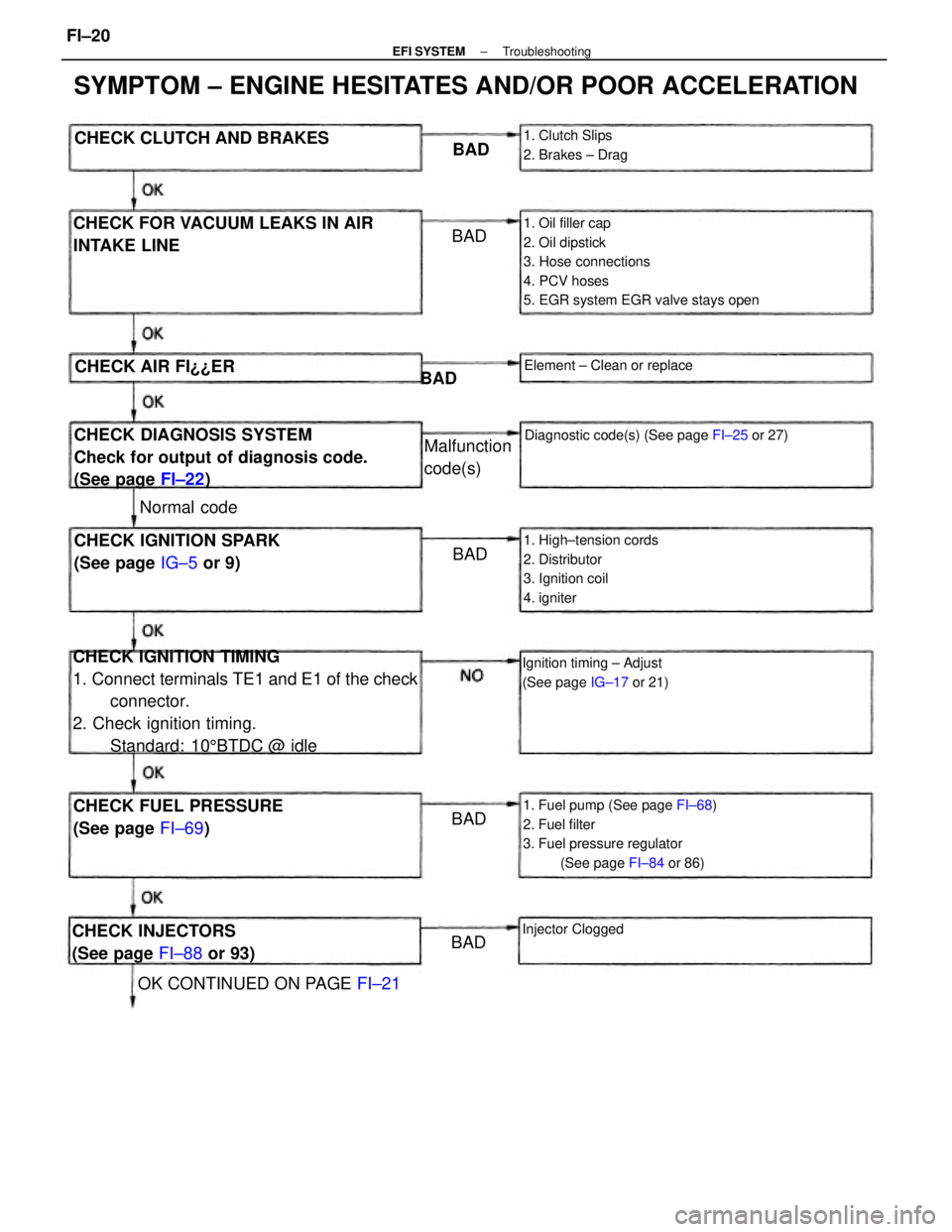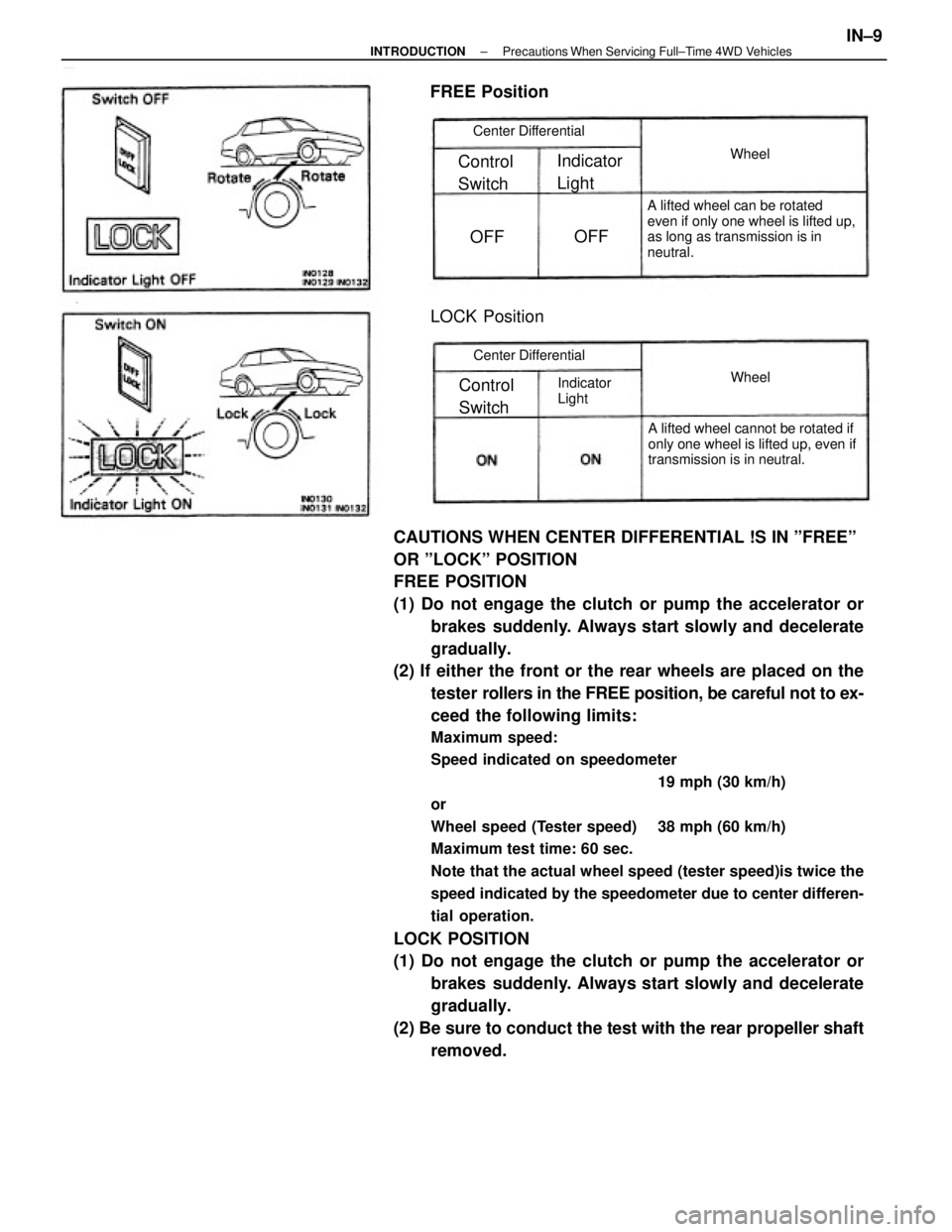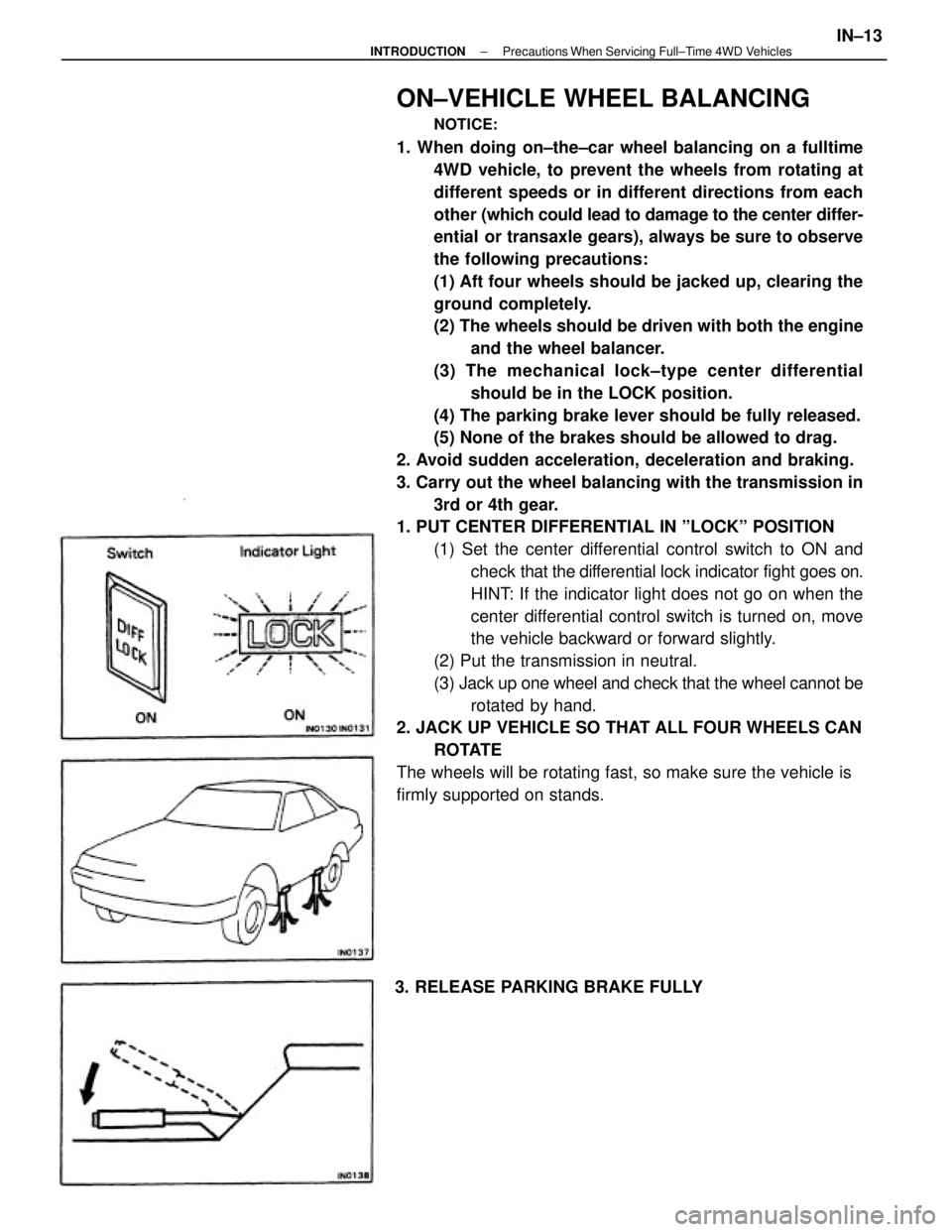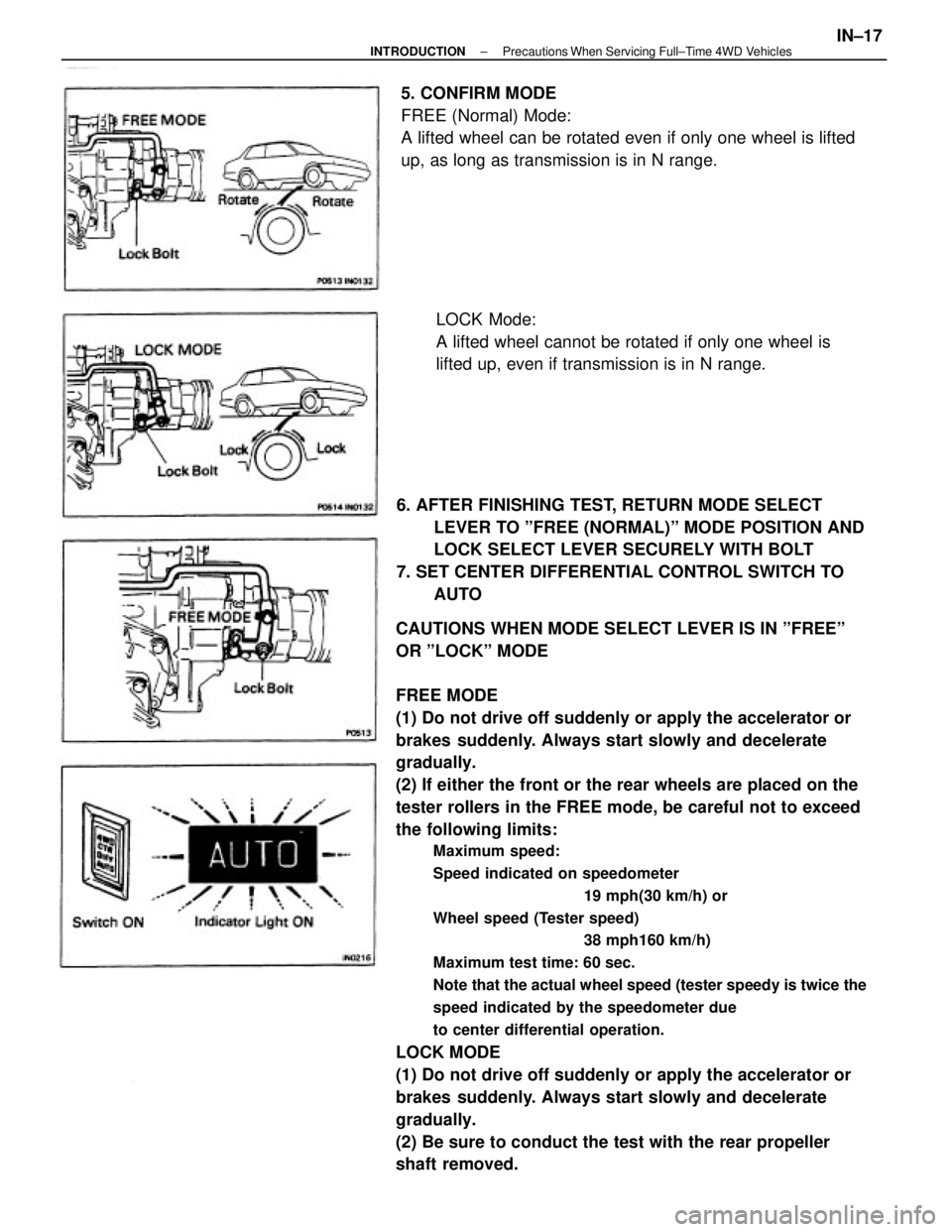Page 922 of 2389
Does warning light always come on or show
the normal code?
(ignition switch on)
Skidding noise occurs while A.B.S. working.
(A.B.S. works inefficiently) A.6.S. operates just before stopping at ordinary braking.
Brake pedal pulsates abnormally while A.B.S. is operating.
Does not come on for 3 seconds after ignition switch on.
Disconnect check connector.
(See page BR±68)Always comes on after ignition switch is turned on.
ºANTIL4CKº warning light comes on.
Troubleshooting
See diagnostic code.
(See page BR±69) A.6.S. operates at ordinary braking.
Continued on page
BR±72. ºANTILOCKº warning light
Comes on while running.
Braking inefficient.
Comes on and off.
Brake workingBrakes pull.
Problem
YESNo.
± BRAKE SYSTEMAnti±lock Brake System (A.B.S.)BR±71
Page 925 of 2389

wCheck connector is disconnected.
wOpen circuit in wire harness between computer terminal T and actuator terminal T.
wActuator terminal GND is improperly connected or open circuit in wire harness between actuator
terminal GND and body ground.
wConnect circuit in wire harness between computer terminal Ts and Ts connector. (For 4WD)
wBrakes pull.
wBraking inefficient.
wA.B.S. operates at ordinary braking.
wA.B.S. operates just before stopping at ordinary braking.
wBrake pedal pulsates abnormally while A.B.S. working.
Disconnect connector from computer, inspect
continuity between each speed sensor termi-
nals on wire harness side.
(See page BR±103) Are each speed sensors installed in place?
And are each installation bolts tightened se-
curely?Does warning light show the diagnostic
normal code? (Ignition switch on)ºANTILOCKº warning light comes on and off.
Disconnect check connector.
(See page BR±68)
See diagnostic code.
(See page BR±69)
Speed sensor installation faulty.
Continued on page BR±75 YES
YES
± BRAKE SYSTEMAnti±lock Brake System (A.B.S.)BR±74
Page 1034 of 2389

CHECK IGNITION TIMING
1. Connect terminals TE1 and E1 of the check
connector.
2. Check ignition timing.
Standard: 105BTDC @ idle
1. Oil filler cap
2. Oil dipstick
3. Hose connections
4. PCV hoses
5. EGR system EGR valve stays open
SYMPTOM ± ENGINE HESITATES AND/OR POOR ACCELERATION
1. Fuel pump (See page FI±68)
2. Fuel filter
3. Fuel pressure regulator
(See page FI±84 or 86)
CHECK DIAGNOSIS SYSTEM
Check for output of diagnosis code.
(See page FI±22) CHECK FOR VACUUM LEAKS IN AIR
INTAKE LINE
1. High±tension cords
2. Distributor
3. Ignition coil
4. igniterCHECK IGNITION SPARK
(See page IG±5 or 9)
CHECK FUEL PRESSURE
(See page FI±69)
Diagnostic code(s) (See page FI±25 or 27)
Ignition timing ± Adjust
(See page IG±17 or 21)
CHECK INJECTORS
(See page FI±88 or 93)
OK CONTINUED ON PAGE FI±21 CHECK CLUTCH AND BRAKES
1. Clutch Slips
2. Brakes ± Drag
Element ± Clean or replace
Malfunction
code(s)
Injector Clogged
CHECK AIR FI¿¿ER
Normal codeBAD
BADBAD
BADBAD BAD
± EFI SYSTEMTroubleshootingFI±20
Page 1186 of 2389
Fuel leak
Air cleaner clogged
Incorrect ignition timing
EFI system problems
wInjector faulty
wDeceleration fuel cut system faulty
Idle speed too high
Spark plug faulty
EGR system always on
Low compression
Tires improperly inflated
Clutch slips
Brakes drag
Incorrect idle speed
Incorrect ignition timing
Vacuum leaks
wPCV line
wEGR line
wIntake manifold
wAir intake chamber
wThrottle body
wISC valve
wBrake booster line
EFI system problemsCheck ISC system
Inspect plugs
Check EGR system
Check compression
Inflate tires to proper pressure
Troubleshoot clutch
Troubleshoot brakesRepair as necessary
Check air cleaner
Reset timing
Repair as necessary
EXCESSIVE FUEL CONSUMPTION
Check ISC system
Reset timing
Repair as necessaryFI±116,118
IG±6, 10
EC±8, 21
EM±22
UNPLEASANT ODOR
Poor gasoline
mileage
FI±116, 118
IG±16, 20
Repair as necessaryMA±5
IG±16, 20
Unpleasant odorPossible cause Possible cause
Problem
ProblemRemedy
RemedyPage Page
± ENGINE MECHANICALTroubleshootingEM±9
Page 1866 of 2389

CAUTIONS WHEN CENTER DIFFERENTIAL !S IN ºFREEº
OR ºLOCKº POSITION
FREE POSITION
(1) Do not engage the clutch or pump the accelerator or
brakes suddenly. Always start slowly and decelerate
gradually.
(2) If either the front or the rear wheels are placed on the
tester rollers in the FREE position, be careful not to ex-
ceed the following limits:
Maximum speed:
Speed indicated on speedometer
19 mph (30 km/h)
or
Wheel speed (Tester speed) 38 mph (60 km/h)
Maximum test time: 60 sec.
Note that the actual wheel speed (tester speed)is twice the
speed indicated by the speedometer due to center differen-
tial operation.
LOCK POSITION
(1) Do not engage the clutch or pump the accelerator or
brakes suddenly. Always start slowly and decelerate
gradually.
(2) Be sure to conduct the test with the rear propeller shaft
removed.
A lifted wheel can be rotated
even if only one wheel is lifted up,
as long as transmission is in
neutral.
A lifted wheel cannot be rotated if
only one wheel is lifted up, even if
transmission is in neutral.
LOCK Position
Center Differential
Center Differential
Indicator
Light
Indicator
Light
FREE Position
Control
Switch Control
Switch
Wheel Wheel
OFFOFF
± INTRODUCTIONPrecautions When Servicing Full±Time 4WD VehiclesIN±9
Page 1870 of 2389

ON±VEHICLE WHEEL BALANCING
NOTICE:
1. When doing on±the±car wheel balancing on a fulltime
4WD vehicle, to prevent the wheels from rotating at
different speeds or in different directions from each
other (which could lead to damage to the center differ-
ential or transaxle gears), always be sure to observe
the following precautions:
(1) Aft four wheels should be jacked up, clearing the
ground completely.
(2) The wheels should be driven with both the engine
and the wheel balancer.
(3) The mechanical lock±type center differential
should be in the LOCK position.
(4) The parking brake lever should be fully released.
(5) None of the brakes should be allowed to drag.
2. Avoid sudden acceleration, deceleration and braking.
3. Carry out the wheel balancing with the transmission in
3rd or 4th gear.
1. PUT CENTER DIFFERENTIAL IN ºLOCKº POSITION
(1) Set the center differential control switch to ON and
check that the differential lock indicator fight goes on.
HINT: If the indicator light does not go on when the
center differential control switch is turned on, move
the vehicle backward or forward slightly.
(2) Put the transmission in neutral.
(3) Jack up one wheel and check that the wheel cannot be
rotated by hand.
2. JACK UP VEHICLE SO THAT ALL FOUR WHEELS CAN
ROTATE
The wheels will be rotating fast, so make sure the vehicle is
firmly supported on stands.
3. RELEASE PARKING BRAKE FULLY
± INTRODUCTIONPrecautions When Servicing Full±Time 4WD VehiclesIN±13
Page 1871 of 2389
9. SET CENTER DIFFERENTIAL CONTROL SWITCH TO
OFF
HINT: If the indicator light does not go off when the center
differential control switch is turned off, move the vehicle
backward or forward slightly and check that the indicator light
goes off.8. ROTATE WHEELS USING BOTH ENGINE'S DRIVING
FORCE AND DRIVING FORCE OF WHEEL BALANCER
AND CHECK WHEEL BALANCE
HINT: When doing this be careful of the other wheels, which
will rotate at the same time. 6. START ENGINE
7. PUT TRANSMISSION IN 3RD OR 4TH GEAR AND
ENGAGE CLUTCH SLOWLY, THEN GRADUALLY
INCREASE SPEED TO TEST SPEED 5. PLACE WHEEL TO BE BALANCED ON WHEEL
BALANCER
Follow the procedure specified by the wheel balancer
manufacturer. 4. MAKE SURE THAT BRAKES ARE NOT DRAGGING ON
ANY OF FOUR WHEELS
± INTRODUCTIONPrecautions When Servicing Full±Time 4WD VehiclesIN±14
Page 1874 of 2389

CAUTIONS WHEN MODE SELECT LEVER IS IN ºFREEº
OR ºLOCKº MODE
FREE MODE
(1) Do not drive off suddenly or apply the accelerator or
brakes suddenly. Always start slowly and decelerate
gradually.
(2) If either the front or the rear wheels are placed on the
tester rollers in the FREE mode, be careful not to exceed
the following limits:
Maximum speed:
Speed indicated on speedometer
19 mph(30 km/h) or
Wheel speed (Tester speed)
38 mph160 km/h)
Maximum test time: 60 sec.
Note that the actual wheel speed (tester speedy is twice the
speed indicated by the speedometer due
to center differential operation.
LOCK MODE
(1) Do not drive off suddenly or apply the accelerator or
brakes suddenly. Always start slowly and decelerate
gradually.
(2) Be sure to conduct the test with the rear propeller
shaft removed.6. AFTER FINISHING TEST, RETURN MODE SELECT
LEVER TO ºFREE (NORMAL)º MODE POSITION AND
LOCK SELECT LEVER SECURELY WITH BOLT
7. SET CENTER DIFFERENTIAL CONTROL SWITCH TO
AUTO 5. CONFIRM MODE
FREE (Normal) Mode:
A lifted wheel can be rotated even if only one wheel is lifted
up, as long as transmission is in N range.
LOCK Mode:
A lifted wheel cannot be rotated if only one wheel is
lifted up, even if transmission is in N range.
± INTRODUCTIONPrecautions When Servicing Full±Time 4WD VehiclesIN±17